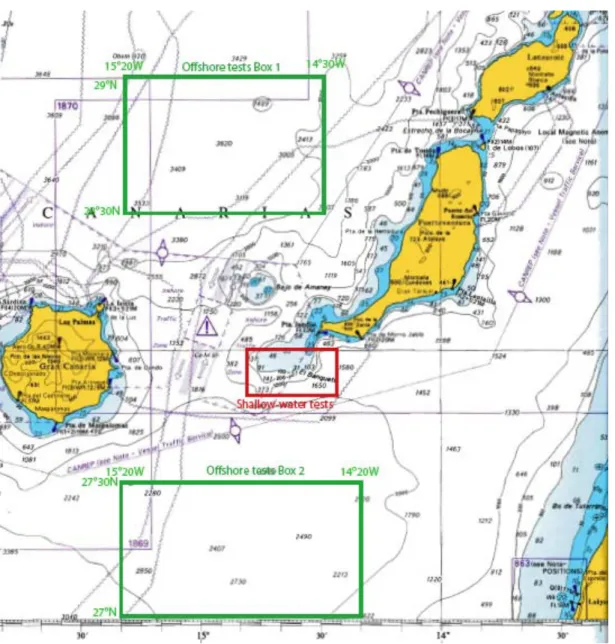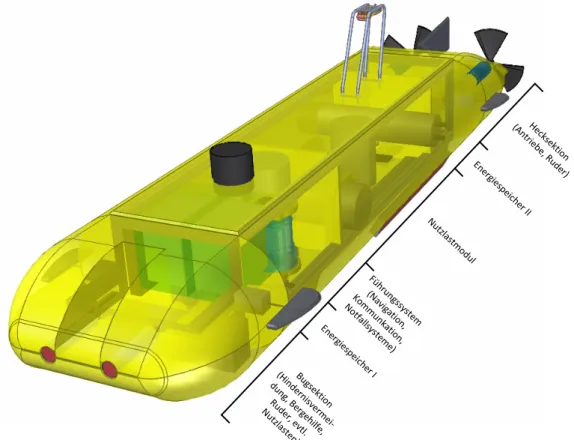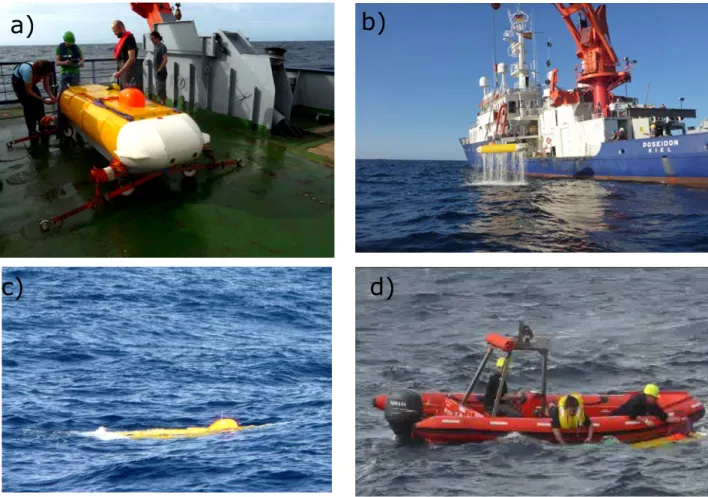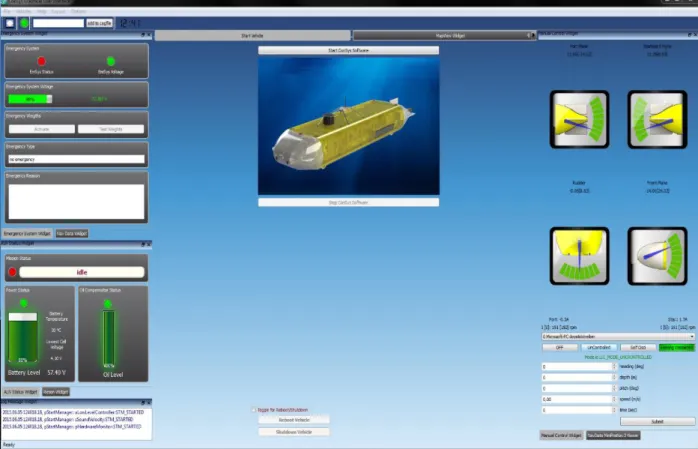GEOMAR REPORT Berichte aus dem GEOMAR
Helmholtz-Zentrum für Ozeanforschung Kiel
Nr. 28 (N. Ser.)
RV POSEIDON
Fahrtbericht / Cruise Report POS493
AUV DEDAVE Test Cruise Las Palmas - Las Palmas (Spain)
26.01.-01.02.2016
Berichte aus dem GEOMAR
Helmholtz-Zentrum für Ozeanforschung Kiel
Nr. 28 (N. Ser.)
RV POSEIDON
Fahrtbericht / Cruise Report POS493
AUV DEDAVE Test Cruise Las Palmas - Las Palmas (Spain)
26.01.-01.02.2016
Herausgeber / Editor:
Klas Lackschewitz
GEOMAR Report
ISSN N.. 2193-8113, DOI 10.3289/GEOMAR_REP_NS_28_2016r
Helmholtz-Zentrum für Ozeanforschung Kiel / Helmholtz Centre for Ocean Research Kiel GEOMAR
Dienstgebäude Westufer / West Shore Building Düsternbrooker Weg 20
D-24105 Kiel Germany
GEOMAR
Dienstgebäude Ostufer / East Shore Building Wischhofstr. 1-3
D-24148 Kiel Germany
Tel.: +49 431 600-0 Fax: +49 431 600-2805 www.geomar.de
Das GEOMAR Helmholtz-Zentrum für Ozeanforschung Kiel ist Mitglied der Helmholtz-Gemeinschaft
Deutscher Forschungszentren e.V.
The GEOMAR Helmholtz Centre for Ocean Research Kiel is a member of the Helmholtz Association of
German Research Centres
Helmholtz-Zentrum für Ozeanforschung Kiel / Helmholtz Centre for Ocean Research Kiel
2016
Test cruise for AUV “DeDAvE” around the Canary Islands Edited by K.S. Lackschewitz
Contact:
Dr. K.S. Lackschewitz
GEOMAR Helmholtz-Zentrum für Ozeanforschung Dienstgebäude Ostufer
Wischhofstr. 1-3 D-24148 Kiel
Phone: 049-431-600-2132 Fax: 049-431-600-1601
E-mail: klackschewitz@geomar.de
Scientific Party & Crew
Scientific Party
Lackschewitz, Klas GEOMAR, Kiel
Bataar, Ganzorig Fraunhofer Gesellschaft
Jacobi, Marco Fraunhofer Gesellschaft
Matz, Sebastian Fraunhofer Gesellschaft
Morgenroth, Jens Fraunhofer Gesellschaft
Pfützenreuter, Torsten Fraunhofer Gesellschaft
Rauschenbach, Thomas Fraunhofer Gesellschaft
Renkewitz, Helge Fraunhofer Gesellschaft
Weber, Daniel Fraunhofer Gesellschaft
Woock, Philipp Fraunhofer Gesellschaft
Crew
Günther, Matthias Captain
Korte, Detlef 1st mate
Nannen, Hero 2nd mate
Kröger, Kurre Klass First engineer
Pieper, Carsten Second engineer
Blunck, Voler Electrician
Wieden, Wilhelm Cook
Gerischewski, Bernd Steward
Mischker, Joachim Bosun
Meyer, Felix Ship mechanic
Heyne, Roland Ship mechanic
Von Keller, Magnus Seaman
Kuhn,Ronald Seaman
Rauh, Bernd Ship mechanic
Cruise Report POS493 (AUV DeDAVE) – Canary Islands, January 26th to February 1st, 2016
- 3 -
1 Introduction
K.S. Lackschewitz and T. Rauschenbach
The 493st cruise of the research vessel POSEIDON had purely technical aims, testing the newly-developed, Autonomous Underwater Vehicle (AUV) by the Fraunhofer Gesellschaft.
The vehicle was funded by the Fraunhofer Gesellschaft 4D-Program “Discover, Define, Develop and Deploy”.
Maritime technologies will play an important economic and scientific role in the deep sea.
With the general rise in raw material procurement costs will increase the importance of deep-sea deposits. Their development requires the exploration and surveying (mapping) and their operation requires a regular monitoring (inspection). The same applies to transport of raw materials to lines and cable for information and energy transfer. The study of flora and fauna and the geological structures of the oceans, especially under the influ- ence of climate changes on earth, also requires the use of suitable deep sea autonomous underwater vehicles. The technologies needed for exploration and inspection especially in the deep sea are not yet developed enough and too expensive. Up to this point are only a few highly specialized, very expensive underwater vehicles available, although many tasks are automatically executable routine activities. It lacks cost-effective modular systems that can be adapted to the tasks to be solved. Especially lacking efficient energy storage, high- resolution sensors, effective method for evaluating the sensor data and control systems for a wide range of responsibilities of future underwater vehicles.
The aim of the 4D-Program is to provide technologies for the development of pressure- neutral and therefore more cost-effective, modular AUVs for use in the deep sea to reduce the above deficits. Pressure neutrality means that all functional units (computers, sensors, energy storage device, drives) to the prevailing ambient pressure are directly exposed and no pressure resistant hull consists. Intelligent multi-sensor imaging and ultrasonic sensors, which provide information are fused, the AUV for inspection and exploration abilities. The new technologies will be developed until a state of production. With DeDAvE (Deep-water AUV for Exploration) the technological leadership will be sought in the field of development of modular, autonomous underwater vehicles for exploration tasks. The results for the achievement of the ambitious project goals per required innovation from many years’ ex- perience of partners in the development and implementation of industrial components for underwater vehicles.
Based on targeted strategic investment measures in advance of the complainants was an infrastructure (pressure chamber, two underwater vehicles, vehicle testing pool) created that fosters the success of the 4D-Program much. The consortium now has a unique base in Germany for the proposed project, which will increase the leverage of the already made significant strategic investments.
For testing purposes several working areas close to the Canary Islands (Spain) were cho- sen that span water depths between 50m and 3500m (Fig. 1).
2016
Fig. 1: Location of the shallow-water test area south of Fuerteventura and the two proposed mid-water offshore test areas.
Cruise Report POS493 (AUV DeDAVE) – Canary Islands, January 26th to February 1st, 2016
- 5 -
2 Cruise Narrative and Event List
K.S. Lackschewitz and T. Rauschenbach
RV POSEIDON left Las Palmas at 9:30 on 26.01.2016 and took course to the working ar- ea, initially designated as being around 27°57´N/14°39´W. The area has about 80m water depth with some rocky areas rising to 50m. As the trimming of the AUV was the first aim work was begun already during the stay in the harbour. Two deployments during the day- light hours were carried out at the 27th as listed in the event table. On 28.01.16 another two dive missions took place in shallow water working area at 27°57´N/14°39´W. Shallow- water tests (ca. 60m water depth) were carried out for the remainder of the cruise in order to test system integrity and sensor functionality. On 29.01.16 the last dive mission were carried out in the shallow water area. Due to strong winds and high sea state we couldn’t launch the vehicle in the planned deepwater area during the last two days of our cruise.
RV POSEIDON left the working area on January 31th and sailed back to Las Palmas where she arrived in the early morning of February 1th. The container was unloaded shortly after the arrival and the scientists left POSEIDON in the early afternoon of February 1th. Event list for POS493
Day Time (LT) Plan Result
25.01.16 13:00 13:30
Start trim test in the harbour Stop trim test in the harbour
Sucessfull
26.01.16 09:30 Leave harbour of Las Palmas
14:30 Arrive in shallow water working area at 27°57´N/14°39´W 26.01.16 all day Working on the vehicle software
27.01.16 08:00 Test deployments 01 and 02;
deploy vehicle for several mis- sions at the surface to test the control system at different engine speeds and the data recording of the different sensors. The AUV completed several straight- ahead and curving runs.
Instruments used:
Pressure sensor, DVL, GPS, IMU, sound velocity
Vehicle runs at different engine power.
27.01.16 11:15 Recover vehicle Sucessfull
27.01.16 14:45 Test deployments 03 and 04;
deploy vehicle for several mis- sions at the surface to test the manual control with WLAN, to perform the directional control, to test the depth control.
The course control while driving various control parameters were tested.
The vehicle has performed several runs with preset courses
autonomously.
Recover vehicle Succesfull
28.01.
2016
Day Time (LT) Plan Result
28.01.16 09:00 Test dive 01; deploy the vehicle for diving tests;
The depth control while driving various control parameters were tested. Vehicle state data was locked for detailed investigations of control behavior
During the test 48 diving manoeuvers were carried out
Data for optimization of control pa- rameters was stored and investi- gated.
16:00 Recover vehicle Succesful
29.01.16 09:00 Test deployment 05; deploy the vehicle for several dive missions.
The cruise and depth controller were tested during 52 diving manoeuvers with a duration be- tween 2 and 10 minutes
Cruise and depth controller were tested successfully. This is a fun- damental base for the following exploration missions.
16:30 Recover vehicle Succesful
30.01.16 No test dives, because the sea state is too high for launch and recover.
Implementation of new features in the mission control system.
Checking the functionality of the iridium modem for use in the emergency module.
Fixing a problem of the DC pow- er supply.
New features in the mission con- trol system successfully tested.
Problem of the DC power supply is fixed.
31.01.16 No test dives, because the sea state is too high for launch and recover.
Mounting the repaired DC power supply in the vehicle.
Changing the iridium antenna.
Integrate a new control algorithm in the vehicle control system
DC power supply works well in the AUV.
New iridium antenna is more sen- sitive than the old one.
01.02.16 8:00 Arriving at Las Palmas End of cruise
Cruise Report POS493 (AUV DeDAVE) – Canary Islands, January 26th to February 1st, 2016
- 7 -
3 AUV Functions and Capabilities
T. Rauschenbach
The AUV DeDAvE was designed and built by the Fraunhofer Institut für Optronik, System- technik und Bildauswertung (IOSB), Fraunhofer IOSB- AST, and Fraunhofer-Institut für Si- liziumtechnologie (ISIT).
Bugsektion (Hindern
isverm ei- dung, B
ergehilfe, Ruder, e
vtl.
Nutzlasten)
Führun gssystem (Naviga
tion, Kommu
nkation, Notfallsysteme) Energiespe
icher I
Energiespe icher II Nutzlastm
odul
Heckse ktion (Antrie
be, R uder)
Fig. 2: Modules of AUV DEDAVE.
The vehicle consists of the following modules (see Fig. 2):
• Distance sensor module,
• Dive planes modules (bow and stern),
• Battery modules,
• Emergency module,
• Control module,
• Rudder module,
• Main drive modules,
• Payload module
2016
Fig. 3: AUV DEDAVE operations. a) AUV shortly before launch, b) AUV is being launched, c) AUV during the test d) The zodiac had to be used for launch and recovery of the vehicle.
The AUV DeDAvE is equipped with a wireless systems for communication with the opera- tor when on the surface. This WLAN system is optimized for short range, in-water commu- nications. It will often eliminate the need to recover the vehicle between missions. Typical- ly, ranges between the ship and vehicle of 1000 meters are achieved.
Sensors of the base vehicle include a MBES (Reson T20) and Kraken SAS (synthetic ap- erture sonar). But the Kraken SAS is under repair and during the Poseidon mission it is not mounted in the vehicle.
All sensor information collected by the vehicle is marked with time, depth and latitude, and longitude as it is collected, facilitating the rapid and highly automated generation of maps and data profiles. An acoustic communication system permits the vehicle to send status messages to the surface ship containing information about the vehicle’s health, its loca- tion, and some sensor data while it is performing a mission. The acoustic communication system is also used to send data and redirection commands to the vehicle. The AUV uti- lizes electronics, control software, and the laptop based operator interface software.
The vehicle navigates autonomously using a combination of navigation methods, depend- ing on the mission objectives, conditions, and optional equipment enabled.
a) b)
c) d)
Cruise Report POS493 (AUV DeDAVE) – Canary Islands, January 26th to February 1st, 2016
- 9 -
• GPS - Works only on the surface, GPS determines the vehicle’s location on Earth.
GPS determines the “initial position” before the vehicle submerges, and verifies or cor- rects the vehicle’s position when it surfaces during the mission. GPS also plays a criti- cal role during INS alignment.
• Inertial Navigation System (Xsens) - After alignment on the surface, INS continuously integrates acceleration in 3 axes to calculate the vehicle’s position. It uses input from the DVL and the GPS to maintain its alignment.
• Doppler Velocity Log (DVL) - Continuously measures altitude and speed over ground whenever the vehicle can maintain bottom-lock. The DVL must be within range of the bottom to measure altitude and provide bottom-lock for the INS.
A Vehicle Interface Program (VIP), a LINUX and Windows®-based program (Fig. 5) man- ages every aspects of AUV operation, including the following tasks:
• Mission planning on electronic navigation charts (customizable, multi-format)
• Real-time mission monitoring through the acoustic modem
• Real-time support-vessel position and heading through GPS and compass feeds (from the AUV control container)
• Pre-mission system checkout
• Post-mission data analysis, mission play-back, and side-scan review The VIP provides a convenient means of mission planning and programming.
Fig. 4: Screenshot of the LINUX- and Windows®-based vehicle interface program software handling the AUV operations.
2016
4 Acknowledgments
K. Lackschewitz and the Fraunhofer AUV-team thanks the officers and crew of RV POSEIDON for their help, advice and the friendly working environment during the test cruise. The entire AUV team thank the Fraunhofer Gesellschaft for providing the funds to design and built the AUV “DEDAVE”.
GEOMAR Reports
No. Title
1 FS POSEIDON Fahrtbericht / Cruise Report POS421, 08. – 18.11.2011, Kiel - Las Palmas, Ed.: T.J. Müller, 26 pp, DOI:
10.3289/GEOMAR_REP_NS_1_2012
2 Nitrous Oxide Time Series Measurements off Peru – A Collaboration between SFB 754 and IMARPE –, Annual Report 2011, Eds.: Baustian, T., M. Graco, H.W. Bange, G. Flores, J. Ledesma, M. Sarmiento, V. Leon, C.
Robles, O. Moron, 20 pp, DOI: 10.3289/GEOMAR_REP_NS_2_2012
3 FS POSEIDON Fahrtbericht / Cruise Report POS427 – Fluid emissions from mud volcanoes, cold seeps and fluid circulation at the Don-_Kuban deep sea fan (Kerch peninsula, Crimea, Black Sea) – 23.02. – 19.03.2012, Burgas, Bulgaria - Heraklion, Greece, Ed.: J. Bialas, 32 pp, DOI:
10.3289/GEOMAR_REP_NS_3_2012
4 RV CELTIC EXPLORER EUROFLEETS Cruise Report, CE12010 –
ECO2@NorthSea, 20.07. – 06.08.2012, Bremerhaven – Hamburg, Eds.: P.
Linke et al., 65 pp, DOI: 10.3289/GEOMAR_REP_NS_4_2012
5 RV PELAGIA Fahrtbericht / Cruise Report 64PE350/64PE351 – JEDDAH- TRANSECT -, 08.03. – 05.04.2012, Jeddah – Jeddah, 06.04 - 22.04.2012, Jeddah – Duba, Eds.: M. Schmidt, R. Al-Farawati, A. Al-Aidaroos, B.
Kürten and the shipboard scientific party, 154 pp, DOI:
10.3289/GEOMAR_REP_NS_5_2013
6 RV SONNE Fahrtbericht / Cruise Report SO225 - MANIHIKI II Leg 2 The Manihiki Plateau - Origin, Structure and Effects of Oceanic Plateaus and Pleistocene Dynamic of the West Pacific Warm Water Pool, 19.11.2012 - 06.01.2013 Suva / Fiji – Auckland / New Zealand, Eds.: R. Werner, D.
Nürnberg, and F. Hauff and the shipboard scientific party, 176 pp, DOI:
10.3289/GEOMAR_REP_NS_6_2013
7 RV SONNE Fahrtbericht / Cruise Report SO226 – CHRIMP CHatham RIse Methane Pockmarks, 07.01. - 06.02.2013 / Auckland – Lyttleton & 07.02.
– 01.03.2013 / Lyttleton – Wellington, Eds.: Jörg Bialas / Ingo Klaucke / Jasmin Mögeltönder, 126 pp, DOI: 10.3289/GEOMAR_REP_NS_7_2013 8 The SUGAR Toolbox - A library of numerical algorithms and data for
modelling of gas hydrate systems and marine environments, Eds.: Elke Kossel, Nikolaus Bigalke, Elena Piñero, Matthias Haeckel, 168 pp, DOI:
10.3289/GEOMAR_REP_NS_8_2013
9 RV ALKOR Fahrtbericht / Cruise Report AL412, 22.03.-08.04.2013, Kiel – Kiel. Eds: Peter Linke and the shipboard scientific party, 38 pp, DOI:
10.3289/GEOMAR_REP_NS_9_2013
10 Literaturrecherche, Aus- und Bewertung der Datenbasis zur Meerforelle (Salmo trutta trutta L.) Grundlage für ein Projekt zur Optimierung des Meerforellenmanagements in Schleswig-Holstein. Eds.: Christoph Petereit, Thorsten Reusch, Jan Dierking, Albrecht Hahn, 158 pp, DOI:
10.3289/GEOMAR_REP_NS_10_2013
11 RV SONNE Fahrtbericht / Cruise Report SO227 TAIFLUX, 02.04. –
02.05.2013, Kaohsiung – Kaohsiung (Taiwan), Christian Berndt, 105 pp, DOI: 10.3289/GEOMAR_REP_NS_11_2013
12 RV SONNE Fahrtbericht / Cruise Report SO218 SHIVA (Stratospheric Ozone: Halogens in a Varying Atmosphere), 15.-29.11.2011, Singapore - Manila, Philippines, Part 1: SO218- SHIVA Summary Report (in German), Part 2: SO218- SHIVA English reports of participating groups, Eds.: Birgit Quack & Kirstin Krüger, 119 pp, DOI:
10.3289/GEOMAR_REP_NS_12_2013
13 KIEL276 Time Series Data from Moored Current Meters. Madeira Abyssal Plain, 33°N, 22°W, 5285 m water depth, March 1980 – April 2011.
Background Information and Data Compilation. Eds.: Thomas J. Müller and Joanna J. Waniek, 239 pp, DOI: 10.3289/GEOMAR_REP_NS_13_2013 14 RV POSEIDON Fahrtbericht / Cruise Report POS457: ICELAND HAZARDS
Volcanic Risks from Iceland and Climate Change:The Late Quaternary to Anthropogene Development Reykjavík / Iceland – Galway / Ireland, 7.-22.
August 2013. Eds.: Reinhard Werner, Dirk Nürnberg and the shipboard scientific party, 88 pp, DOI: 10.3289/GEOMAR_REP_NS_14_2014 15 RV MARIA S. MERIAN Fahrtbericht / Cruise Report MSM-34 / 1 & 2,
SUGAR Site, Varna – Varna, 06.12.13 – 16.01.14. Eds: Jörg Bialas, Ingo Klaucke, Matthias Haeckel, 111 pp, DOI:
10.3289/GEOMAR_REP_NS_15_2014
16 RV POSEIDON Fahrtbericht / Cruise Report POS 442, “AUVinTYS” High- resolution geological investigations of hydrothermal sites in the Tyrrhenian Sea using the AUV “Abyss”, 31.10. – 09.11.12, Messina – Messina, Ed.:
Sven Petersen, 32 pp, DOI: 10.3289/GEOMAR_REP_NS_16_2014
17 RV SONNE, Fahrtbericht / Cruise Report, SO 234/1, “SPACES”: Science or the Assessment of Complex Earth System Processes, 22.06. –
06.07.2014, Walvis Bay / Namibia - Durban / South Africa, Eds.: Reinhard Werner and Hans-Joachim Wagner and the shipbord scientific party, 44 pp, DOI: 10.3289/GEOMAR_REP_NS_17_2014
18 RV POSEIDON Fahrtbericht / Cruise Report POS 453 & 458, “COMM3D”, Crustal Structure and Ocean Mixing observed with 3D Seismic
Measurements, 20.05. – 12.06.2013 (POS453), Galway, Ireland – Vigo, Portugal, 24.09. – 17.10.2013 (POS458), Vigo, Portugal – Vigo, Portugal, Eds.: Cord Papenberg and Dirk Klaeschen, 66 pp, DOI:
10.3289/GEOMAR_REP_NS_18_2014
19 RV POSEIDON, Fahrtbericht / Cruise Report, POS469, “PANAREA”, 02. – 22.05.2014, (Bari, Italy – Malaga, Spain) & Panarea shallow-water diving campaign, 10. – 19.05.2014, Ed.: Peter Linke, 55 pp, DOI:
10.3289/GEOMAR_REP_NS_19_2014
20 RV SONNE Fahrtbericht / Cruise Report SO234-2, 08.-20.07.2014, Durban, South Africa - Port Louis, Mauritius, Eds.: Kirstin Krüger, Birgit Quack and Christa Marandino, 95 pp, DOI:
10.3289/GEOMAR_REP_NS_20_2014
21 RV SONNE Fahrtbericht / Cruise Report SO235, 23.07.-07.08.2014, Port Louis, Mauritius to Malé, Maldives, Eds.: Kirstin Krüger, Birgit Quack and Christa Marandino, 76 pp, DOI: 10.3289/GEOMAR_REP_NS_21_2014
No. Title
22 RV SONNE Fahrtbericht / Cruise Report SO233 WALVIS II, 14.05- 21.06.2014, Cape Town, South Africa - Walvis Bay, Namibia, Eds.: Kaj Hoernle, Reinhard Werner, and Carsten Lüter, 153 pp, DOI:
10.3289/GEOMAR_REP_NS_22_2014
23 RV SONNE Fahrtbericht / Cruise Report SO237 Vema-TRANSIT Bathymetry of the Vema-Fracture Zone and Puerto Rico TRench and Abyssal AtlaNtic BiodiverSITy Study, Las Palmas (Spain) - Santo Domingo (Dom. Rep.) 14.12.14 - 26.01.15, Ed.: Colin W. Devey, 130 pp, DOI:
10.3289/GEOMAR_REP_NS_23_2015
24 RV POSEIDON Fahrtbericht / Cruise Report POS430, POS440, POS460 &
POS467 Seismic Hazards to the Southwest of Portugal; POS430 - La- Seyne-sur-Mer - Portimao (7.4. - 14.4.2012), POS440 - Lisbon - Faro (12.10. - 19.10.2012), POS460 - Funchal - Portimao (5.10. - 14.10.2013), POS467 - Funchal - Portimao (21.3. - 27.3.2014), Ed.: Ingo Grevemeyer, 43 pp, DOI: 10.3289/GEOMAR_REP_NS_24_2015
25 RV SONNE Fahrtbericht / Cruise Report SO239, EcoResponse Assessing the Ecology, Connectivity and Resilience of Polymetallic Nodule Field Systems, Balboa (Panama) – Manzanillo (Mexico), 11.03. -30.04.2015, Eds.: Pedro Martínez Arbizu and Matthias Haeckel, 204 pp, DOI:
10.3289/GEOMAR_REP_NS_25_2015
26 RV SONNE Fahrtbericht / Cruise Report SO242-1, JPI OCEANS Ecological Aspects of Deep-Sea Mining, DISCOL Revisited, Guayaquil - Guayaquil (Equador), 29.07.-25.08.2015, Ed.: Jens Greinert, 290 pp, DOI:
10.3289/GEOMAR_REP_NS_26_2015
27 RV SONNE Fahrtbericht / Cruise Report SO242-2 JPI OCEANS Ecological Aspects of Deep-Sea Mining DISCOL Revisited, Guayaquil - Guayaquil (Equador), 28.08.-01.10.2015, Ed.: Antje Boetius, 552 pp, DOI:
10.3289/GEOMAR_REP_NS_27_2015
For GEOMAR Reports, please visit:
https://oceanrep.geomar.de/view/series/GEOMAR_Report.html Reports of the former IFM-GEOMAR series can be found under:
https://oceanrep.geomar.de/view/series/IFM-GEOMAR_Report.html
Helmholtz-Zentrum für Ozeanforschung Kiel / Helmholtz Centre for Ocean Research Kiel GEOMAR
Dienstgebäude Westufer / West Shore Building Düsternbrooker Weg 20
D-24105 Kiel Germany
GEOMAR
Dienstgebäude Ostufer / East Shore Building Wischhofstr. 1-3
D-24148 Kiel Germany
Deutscher Forschungszentren e.V. German Research Centres
Helmholtz-Zentrum für Ozeanforschung Kiel / Helmholtz Centre for Ocean Research Kiel



